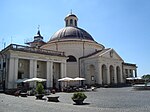Sanctuary of Santa Maria della Rotonda

The sanctuary of Maria Santissima della Rotonda ('a Ritonna in Albano dialect), formerly known as Santa Maria Maggiore, is an important Marian sanctuary in Lazio, located in the city of Albano Laziale, in the province of Rome, in the Roman Castles area. The sanctuary occupies an ancient round building of Roman construction dating back to the 1st century, traceable to Domitian's villa at Castel Gandolfo, which was formerly a nymphaeum or, according to other hypotheses, a temple. The building was converted to Christian use at the time of Constantine the Great or in the period between the 9th and 11th centuries.Probably run in the first centuries of its existence by religious of the Byzantine rite, it was managed by Augustinian nuns from the 14th century until 1444 and was later assigned to the Girolaminian religious of the basilica of Saints Boniface and Alexius on the Aventine Hill in Rome, who held it until 1663, when the sanctuary was purchased by the suburbicarian diocese of Albano for the purpose of installing the bishop's seminary there. Between 1708 and 1799, the direction of the seminary and the sanctuary passed to the Piarist Fathers. Since then, the sanctuary has been diocesan property and is attached to the parish of the cathedral basilica of San Pancrazio. Today it is listed among the protected architectural monuments of Lazio.
Excerpt from the Wikipedia article Sanctuary of Santa Maria della Rotonda (License: CC BY-SA 3.0, Authors, Images).Sanctuary of Santa Maria della Rotonda
Via Don Minzoni,
Geographical coordinates (GPS) Address Nearby Places Show on map
Geographical coordinates (GPS)
| Latitude | Longitude |
|---|---|
| N 41.73012 ° | E 12.65934 ° |
Address
Chiesa Santa Maria della Rotonda
Via Don Minzoni
00041
Lazio, Italy
Open on Google Maps










